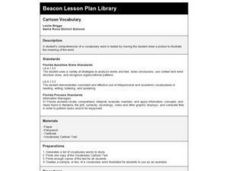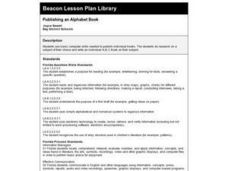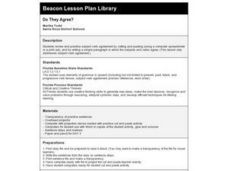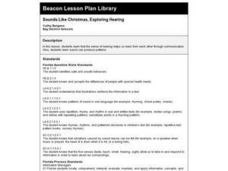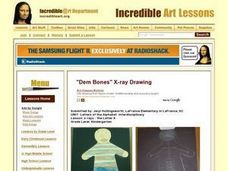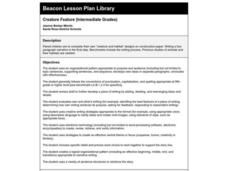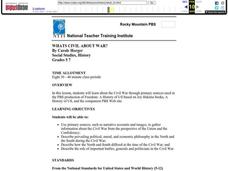Curated OER
Cartoon Vocabulary
Third and fourth graders complete a vocabulary log which includes a definition, and a sentence that demonstrates the meaning of the word. Then make an illustration that represents the definition of the word. The trick is that they may...
Curated OER
Using Technology For Vocabulary Development, reading Comprehension, and Word Identification
Fourth graders define unknown vocabulary words and decode unknown words in their reading using a Quicktionary Reading Pen and Franklin Spell Checker. They create reading comprehension questions that are incorporated into a classroom Web...
Curated OER
Publishing an Alphabet Book
Young scholars research, write and publish an A,B,C book based on research of their own.
Curated OER
A Picture Says a Thousand Words
Students create a writing selection with a well-developed plot. They use a personal photograph in which they are visible to base their autobiographical writing. They write a description of the events surrounding the photograph in the...
Curated OER
Do They Agree?
Fifth graders review and practice subject-verb agreement by cutting and pasting, and by writing a simple paragraph in which the subjects and verbs agree. They utilize worksheets imbedded in this plan to practice subject-verb agreement.
Curated OER
Walking the Line
Students participate in activities that engage all learning styles (such as picture walks, tracing lines, movement/theatre technique) as an introduction to the art element of line and its importance to art.
Curated OER
Kid-Created Biographies
Students create biographies on the people they know best-- their teachers! students use various skills to collect information, organize details, publish the biographies and present the information.
Curated OER
Greek Inquiry Report and Presentation
Sixth graders choose from a list of researchable inquiry questions. They engage in all phases of inquiry/research process.
Curated OER
Is This a House for Hermit Crab?
First graders identify text that uses sequence or other logical order. They identify and interpret how different plants and animals inhabit different kinds of environments and have external features that help them thrive in different...
Curated OER
Sounds Like Christmas, Exploring Hearing
Learners see that the sense of hearing helps us learn from each other through communication. Also, students explain that sound can produce patterns. They engage in a wide variety of activities that focus on the sense of hearing.
Curated OER
x-rays - the Letter X
Students demonstrate the ability to draw vertical, horizontal, and diagonal lines, recognize the difference between inside and outside, and create a picture of themselves.
Curated OER
Powerful Pulleys
Young scholars explore the building of a pyramid and how pulleys were used to change the direction of applied force. They demonstrate the mechanical advantage of using a pulley and apply it to modern engineering.
Curated OER
Rockin? Chalk (Integrating science - make own chalk)
Students use plaster of Paris, talc, and cornstarch to create their own chalk. They hypothesize what mixture of ingredients produce the "best" chalk. Students discuss what they think are the characteristics of the "best" chalk.
Curated OER
Oh, Let the Rain Fall Down
Fifth graders explain the three phases of the water cycle in a narraive paragraph where they describe the journey of a single raindrop. They are introduced to five science vocabulary words and personfication.
Curated OER
Creature Feature
Students work in pairs to create a creature and its habitat out of construction paper. Then students write a narrative to describe the animal and its habitat.
Curated OER
What's Civil About War?
Students study about the Civil War through primary sources used in the PBS production of "Freedom: A History of US" based on Joy Hakim's books, "A History of US", and the companion PBS Web site.
Curated OER
Victorian America: Reflections of Life in Death
Young scholars, after viewing a video and researching the changes in society during the Victorian period, assess a prediction-confirmation guide to consider how changes in burial customs in the late 1800's reflect the changes in society...
Curated OER
Carter as President and Ex-President
Middle schoolers examine how Presidents are judged during their time in office as well as afterwards. They conduct and Internet search for Jimmy Carter's inaugural address and write a news story about his address. Once they have written...
Curated OER
Operation Anitbody
Students identify the types of cells that are important in the immune system. They investigate the different mechanisms used by white blood cells as they protect the body from foreign invaders. Students are given five case studies,...
Curated OER
DNA Models
Students create DNA models. Using puzzle pieces to represent the parts of a DNA strand, they put together a segment of DNA. Once everyone has completed their individual strand, they being linking with other students using tape. Class...
Curated OER
Experiencing Japanese Feudalism
Young scholars identify that a system of feudalism similar to that of medieval Europe developed in Japan by 1300. Students identify the social hierarchy of feudal Japan. Young scholars identify what the cultural basis for the...
Curated OER
Shoes and the Backyard Landscape
Your shoes get a lot of mileage in familiar places. Represent the places you have traveled the most with an art project based on a print of Indian People Wear Shoes and Socks by Juane Quick-to-See Smith. Kids trace their shoes and...
Curated OER
Essay on Themes
Young scholars read the book THE CALL OF THE WILD by Jack London and discuss the different elements in the book. They then write an essay on a theme providing examples backing up their main point of their essay.
Curated OER
Bean There, Done Plant
Students explain that events in nature follow an orderly progression when they plant seeds and observe the development of the seeds. They count seeds and find the likenesses and the differences of many seeds.


